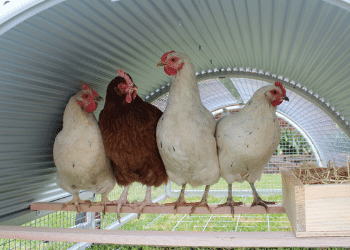Who Rules the Roost in your Chicken Coop?
Categories:
Chicken Behaviour
If you've ever found the time to sit and observe the interactions of backyard chickens, you'll no doubt understand where the term 'pecking order' originated. While you might debate who 'rules the roost' in your home or workplace, you can be sure that there is a clear 'King' or 'Queen' that dominates your backyard chicken coop.
The concept of a 'pecking order' was coined back in the 1920s by biologists who discovered that backyard chickens maintain a hierarchy with one chicken pecking another of lower status. In the absence of a rooster, one particular chicken will dominate all others. The 'pecking order' concept was transferred to human behavior in the 1950s.

Chicken domination
While owners of backyard chickens may not be aware of such a hierarchy, the chickens most definitely know their place in the coop society. If you have chickens in your backyard, take a moment to simply look at the condition of their feathers. There will be one chicken that will stand out with its beautiful crop of feathers entirely intact. If you take a little more time to sit and watch the action in your chicken coop, you'll see that this 'top chook' has been given the right to peck any other chicken in the flock, with no retaliation. While you may not be able to make out the order entirely, there is a definite hierarchy. Each chicken knows whom they are allowed to dominate and whom they need to step aside for in terms of eating first and having the privilege of the best laying boxes and perches. The favourite laying boxes and perches are generally those that are the highest in the chicken coop, and therefore the greatest distance away from predators.
Chicken coop introductions
If you've just taken the step to acquire backyard chickens or are about to do so, be prepared for a short period of intense fighting between your new pets. This fighting determines whether a chicken is dominant or submissive and therefore where they sit in the pecking order. Interestingly, if you remove a chicken from a well-established flock for only a day and then put that bird back in the chicken coop again, fighting amongst the entire flock will reoccur to re-establish the appropriate pecking order. This is also found to occur when a chicken is injured, with their place in the pecking order significantly down-graded as a result.
Adding New Chickens
Of course when you add new chickens to an existing flock of chickens the pecking order needs to be re-established. While it's unlikely that you will be able to prevent fighting completely during this phase of introduction, it pays to try some of the strategies that have been found to help your old and new chickens get to know each other. This includes introducing new chickens at night-time; distracting older birds with treats; and using two coops for a short period side by side.


